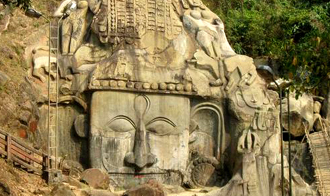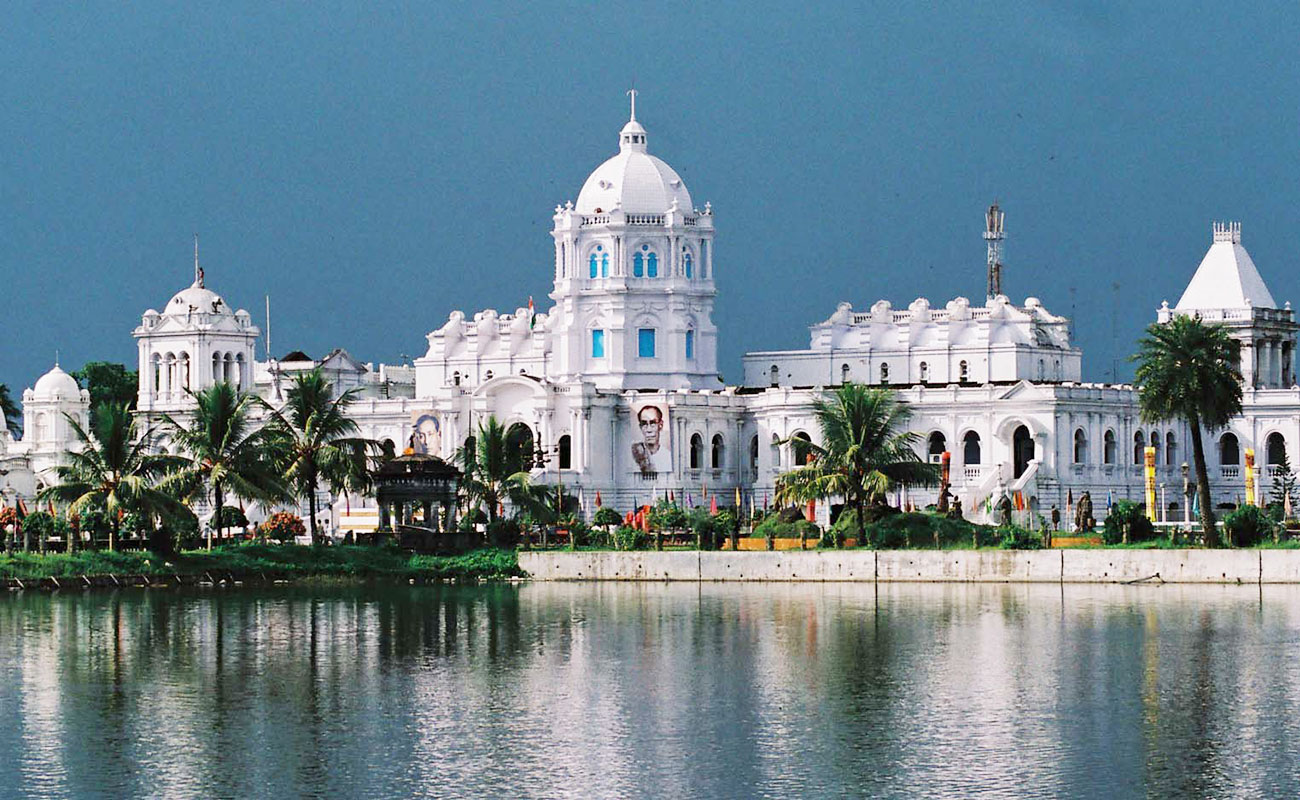Tripura or Twipra, the land of Maharajas, pretty palaces, lakes and temples is reminiscent of the grandeur of Rajasthan. Situated between Bangladesh and Mizoram, this small state is a land of exquisite natural beauty. Tripura is known for its hills, dales and lush valleys. A distinct aspect of the hill formations of Tripura is that they run parallel in a north-south pattern beyond the borders of Bangladesh. Its highest peak is the Betling Shiv (3200 ft) in the Jampui ranges. A rich tourist spot, the Jampui hills are also famous for its orange plantations; and every year it hosts the famous orange festival during December-January. The Eden tourist lodge and several other paying guest accommodations are available in the area. The Boromura hill ranges, which is the source of rivers like Saidra and Sumili that flow into Bangladesh is also known for its natural splendour.
 Tripura has had a fabled past; and before joining India in 1949, this land was ruled for centuries by the Hindu royal dynasty of Manikyas. Though considered a part of British India in the days of the Raj – it still enjoyed the status of an independent administrative unit even then. When India became independent, the then Maharani of Tripura, signed an agreement of merger with the union. Tripura and finally gained complete statehood in 1972.
Tripura has had a fabled past; and before joining India in 1949, this land was ruled for centuries by the Hindu royal dynasty of Manikyas. Though considered a part of British India in the days of the Raj – it still enjoyed the status of an independent administrative unit even then. When India became independent, the then Maharani of Tripura, signed an agreement of merger with the union. Tripura and finally gained complete statehood in 1972.
Just as its variegated culture and multi-hued ethnicity, the origin of the name Tripura has several fascinating legends associated with it. While the name finds mention in the Mahabharata; Hindu mythology attributes the name of Tripura to lord Shiva, who is also called Tripurari. The more common belief is that name directly refers to the presiding deity of the land, ‘Tripura shundari’- which has made the region one of the 51 Shakti peethas, or pilgrimage centres sacred to worshippers of Goddess Durga.
Historical and scholarly records suggest that the name directly refers to the land once known as ‘Tuipra’ – meaning a land adjoining the water. It is a known fact that in the past, the boundaries of the land of Tripura extended up to the Bay of Bengal. While ancient history points to the fact that the Tripuri tribe, also known as Tipras, literally meaning ‘water-god’ - had travelled from Central Asia around 8000 BC and settled in this region.
Though among the earliest settlers of the land were several other Mongoloid communities like the Noatias, Chakmas, Reangs, Jamatis and Halams – the old Tripuris were the predominant tribe. Later with the wave of Bengali immigrants coming in from Bangladesh, the region, and especially the old Tripuris witnessed a radical change in their social and cultural fabric. This resulted in the birth of the Natun Tripuris (literally ‘new Tripuris’), who adopted many Bengali customs, including the Bengali language. It is no surprise therefore, that Bengali is currently one of the major languages of the state apart from Kokborak.
Other known immigrants like the Mundas, Orangs and Santals have contributed to Tripura’s diverse cultural base as well – these people were brought into the state during the time of the monarchy, to work at tea plantations or the brick kiln factories. Each of these tribes has their distinct dances, songs and customs, which have been kept alive to this day.
Various customs and religious festivals enliven Tripura’s colourful cultural heritage. Prominent among these festivals is Bisu – the New Year festival held during March/April. On Bisu, young and old alike participate in religious ceremonies; and young girls and boys perform the Kherbai dance. Being a predominantly Hindu state, people worship several Hindu gods and goddesses during its biggest festivals. Garia (Lord Shiva); Mailu-Ma (lakshmi); Khulu-ma (goddess of cotton plant); the 14 Chaturdasha deities (mainly worshipped by the Manikya royals) and Tripura-Sundari, whose temple stands at the ancient city of Udaipur, 55 kms from Agartala. A unique custom of offering traditionally made alcohol during ceremonies is common in the state. The most popular and prized variety - the Mami ni Chuwak, beer fermented from rice, is offered to Lord Garia and to respected guests on special ceremonies.
Being an agriculturally oriented society, its harvest festivals like Mamita are also very colourful occasions. Held during October, farmers celebrate a good harvest season with the Mamita dance. On this day, traditionally the royal family sacrificed buffaloes to organise a grand feast.
Tripura’s unique wildlife can be best savoured at Siphajhola sanctuary – woodland with an artificial lake, here tourists can view over 150 species of birds and the bespectacled monkey, Phayre’s Langur, known locally as ‘Chosma Mwkhwra’. Other notable locations for wildlife include Shilghati, on the banks of river Gomati, 16 kms from Udaipur. Shilghati is known for its unique flora and fauna. A large variety of fish is found here. Also, the state’s valuable elephant herds can be seen in Kalajhari hills ranges.
Like Rajasthan, royal Tripura is best preserved in several places in the state. Kamalasagar, an artificial lake built by King Dhanya Manikya of Tripura in the 15th century - today it is a popular spot for picnickers as well. Neermahal or Water Palace, 53 kms from Agartala, instantly reminds one of Lake Pichola palace in Udaipur. Built by King Bir Bikram Kishore Debburman in 1930, this beautiful edifice, elegantly combines Hindu and Muslim architectural styles all standing firmly at the centre of lake Rudrasagar.
Tripuras handicrafts and handlooms occupy a distinct place in India’s heritage. Cane and bamboo artefacts and the light cotton weaves are well-known. Interestingly the rignai, the cloth used by women to wear as a wrap – has close to 300 design patterns, all crafted during the reign of Maharaj Trilochana.
Apart from the many private hotels in the capital city of Agartala, there are several good accommodations available at all tourist destinations of Tripura.


